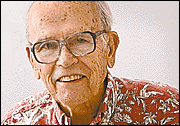


Hawaii’s World
THE tally on installed markers for a Waikiki Historic Trail is nine in place, six others pretty well committed and five to go -- total 20. On the trail of
historic WaikikiThe trail should do a lot to promote awareness of Waikiki back to the years when Hawaiian chiefs made it Oahu's seat of government for nearly four centuries.
Thousands of people lived, worked and fished among its countless fishponds and vast taro fields extending from the shore to the foothills of Manoa Valley.
The historical markers use text developed by Hawaiiana specialist George Kanahele and are part of a much larger Hawaiian awareness program he has been urging for Waikiki. They will tell the story in considerable detail to history buffs or, at a fairly quick glance, to headline readers.
The No. 1 marker is at the Kapahulu Groin in Waikiki. No. 20 is the King Kalakaua statue at the intersection of Kalakaua and Kuhio Avenues. Both coastal and inland markers are in between. Ideally a printed brochure will guide persons along the trail.
The volunteer honcho of the work is Charles H. Palumbo, an architect who "really fell in love with the project" and labors on a not-for-profit basis to persuade hotels and estates to fund markers for their properties. He has the blessing of the City and County of Honolulu, which has funded several markers, and the Waikiki Improvement Association.
Except where statues or monuments already were in place, as with those for Duke Kahanamoku and King Kalakaua, the markers will be bronze surfboards made with stainless steel and precast concrete to stand some eight feet high. Cost: $12,500 each.
Surfboard markers now are at the Kapahulu Groin, Prince Kuhio Beach, 'Aina Hau Park/Triangle on Kuhio Avenue, Duke's Beach in front of the Hilton Hawaiian Village and on the Ala Wai side of the Hawaii Convention Center.
Other existing sites on the trail are the Kapaemahu Healer's Stones at Kuhio Beach and the Moana Hotel, a monument itself as Waikiki's first hotel.
The Historic Trail likely will be the most tangible accomplishment in "Restoring Hawaiianness to Waikiki" as advocated five years ago in a publication authored by Kanahele through the WAIAHA Foundation chaired by Kenneth Brown.
LAST July, the WAIAHA Foundation issued a follow-up publication enumerating 74 ideas on which some action has been taken, 69 on which little action has been taken and 41 new recommendations for a total of 181.
Areas of progress include the pending clean-up of the Ala Wai Canal, incorporation of Hawaiiana into the Diamond Head State Monument Master Plan, marine life conservation, promotion of torch fishing off Waikiki, hotels putting up signage to identify Hawaiian plants as at Hale Koa and Hilton Hawaiian Village, promotion of more Hawaiian awareness by hotel employees, more use of the words aloha and mahalo, employee singing groups and song contests, more use of common Hawaiian terms (kane, wahine, mauka, makai), strolling street musicians, a revival of walking tours, more benches and chairs along the Ala Wai and Kuhio Beach.
He would like to see a Preservation Hall created after the fashion of the jazz Preservation Hall in New Orleans and wishes hotels could find it in their budgets to present more floral leis to their guests.
He counted at least 25 hotels, restaurants or night clubs in Waikiki that offer some form of Hawaiian entertainment. Thus this situation may not be as desperate as some seem to think.
A.A. Smyser is the contributing editor
and former editor of the the Star-Bulletin
His column runs Tuesday and Thursday.